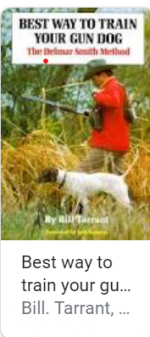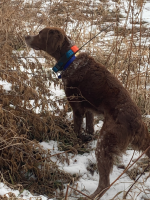Hello All! This is my first post and I'm happy to be here to learn from you all.
I have a question about introduction to the E-Collar for my year old Brittany. Heres a little background:
My wife and I got a male Brittany earlier this year, fully understanding that he might not have hunting potential. However, he has shown pretty good prey drive with rabbits/pigeons/etc.
on our neighborhood walks and we wanted to get him started with some training.
He has had a couple of training sessions this far and has shown great pointing steadiness. His introduction to the gun seems to be going well too. We then moved onto tossing pigeons to get him interested in birds. In our first session, my dog chased pigeons for a hundred yards the first few times before responding well to an e-collar for recall on the lowest setting on the last several. He then stopped following the birds after about 30 yards of flight and returned with reliability without need for stimulation. In our second session, he started out with the collar on and only chased the birds about 30 yards or so again the whole time. He also wasn't ranging out in the brush as far as the first week, but he also knew that we had pigeons in the bag with us, which might have been why he stayed close.
The first session was the first time he ever wore a collar and our plan is to back off the collar for a while. He seemed very interested in the birds, but just didn't pursue then to the same level that he had the very first few flights. Is it possible he is responding to the collar and shutting down a little? Or is he simply learning that chasing the birds for hundreds of yards is fruitless and returning once they are out of reach? I like a dog that works close, but I want to make sure that it is fun for him and he associates birds with being outside. Any insight or recommendations on what might be going on? Or am I reading too much into it?
I have a question about introduction to the E-Collar for my year old Brittany. Heres a little background:
My wife and I got a male Brittany earlier this year, fully understanding that he might not have hunting potential. However, he has shown pretty good prey drive with rabbits/pigeons/etc.
on our neighborhood walks and we wanted to get him started with some training.
He has had a couple of training sessions this far and has shown great pointing steadiness. His introduction to the gun seems to be going well too. We then moved onto tossing pigeons to get him interested in birds. In our first session, my dog chased pigeons for a hundred yards the first few times before responding well to an e-collar for recall on the lowest setting on the last several. He then stopped following the birds after about 30 yards of flight and returned with reliability without need for stimulation. In our second session, he started out with the collar on and only chased the birds about 30 yards or so again the whole time. He also wasn't ranging out in the brush as far as the first week, but he also knew that we had pigeons in the bag with us, which might have been why he stayed close.
The first session was the first time he ever wore a collar and our plan is to back off the collar for a while. He seemed very interested in the birds, but just didn't pursue then to the same level that he had the very first few flights. Is it possible he is responding to the collar and shutting down a little? Or is he simply learning that chasing the birds for hundreds of yards is fruitless and returning once they are out of reach? I like a dog that works close, but I want to make sure that it is fun for him and he associates birds with being outside. Any insight or recommendations on what might be going on? Or am I reading too much into it?
Last edited:



